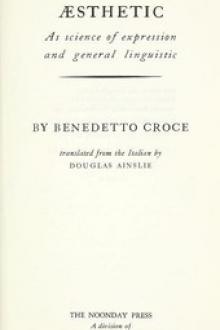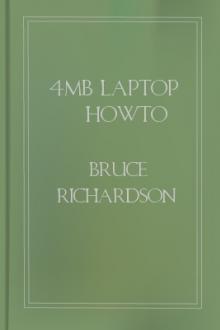Aesthetic as Science of Expression and General Linguistic, Benedetto Croce [read e books online free TXT] 📗

- Author: Benedetto Croce
- Performer: 1426434839
Book online «Aesthetic as Science of Expression and General Linguistic, Benedetto Croce [read e books online free TXT] 📗». Author Benedetto Croce
However, it will be better to leave it at this point in suspense, for it is not at present necessary to prosecute this line of inquiry any further. The mention already made must suffice to prevent our having spoken of the physical element as of something objective and existing, for reasons of simplicity and adhesion to ordinary language, from leading to hasty conclusions as to the concepts and the connexion between spirit and nature.
[Sidenote] Expression in the aesthetic sense, and expression in the naturalistic sense.
It is important to make clear that as the existence of the hedonistic side in every spiritual activity has given rise to the confusion between the aesthetic activity and the useful or pleasurable, so the existence, or, better, the possibility of constructing this physical side, has generated the confusion between aesthetic expression and expression in the naturalistic sense; between a spiritual fact, that is to say, and a mechanical and passive fact (not to say, between a concrete reality and an abstraction or fiction). In common speech, sometimes it is the words of the poet that are called expressions, the notes of the musician, or the figures of the painter; sometimes the blush which is wont to accompany the feeling of shame, the pallor resulting from fear, the grinding of the teeth proper to violent anger, the glittering of the eyes, and certain movements of the muscles of the mouth, which reveal cheerfulness. A certain degree of heat is also said to be the expression of fever, as the falling of the barometer is of rain, and even that the height of the rate of exchange expresses the discredit of the paper-money of a State, or social discontent the approach of a revolution. One can well imagine what sort of scientific results would be attained by allowing oneself to be governed by linguistic usage and placing in one sheaf facts so widely different. But there is, in fact, an abyss between a man who is the prey of anger with all its natural manifestations, and another man who expresses it aesthetically; between the aspect, the cries, and the contortions of one who is tortured with sorrow at the loss of a dear one, and the words or song with which the same individual portrays his torture at another moment; between the distortion of emotion and the gesture of the actor. Darwin’s book on the expression of the feelings in man and animals does not belong to Aesthetic; because there is nothing in common between the science of spiritual expression and a Semiotic, whether it be medical, meteorological, political, physiognomic, or chiromantic.
Expression in the naturalistic sense simply lacks expression in the spiritual sense, that is to say, the characteristic itself of activity and of spirituality, and therefore the bipartition into poles of beauty and of ugliness. It is nothing more than a relation between cause and effect, fixed by the abstract intellect. The complete process of aesthetic production can be symbolized in four steps, which are: a, impressions; b, expression or spiritual aesthetic synthesis; c, hedonistic accompaniment, or pleasure of the beautiful (aesthetic pleasure); d, translation of the aesthetic fact into physical phenomena (sounds, tones, movements, combinations of lines and colours, etc.). Anyone can see that the capital point, the only one that is properly speaking aesthetic and truly real, is in that b, which is lacking to the mere manifestation or naturalistic construction, metaphorically also called expression.
The expressive process is exhausted when those four steps have been taken. It begins again with new impressions, a new aesthetic synthesis, and relative accompaniments.
[Sidenote] Intuitions and memory.
Expressions or representations follow and expel one another. Certainly, this passing away, this disassociation, is not perishing, it is not total elimination: nothing of what is born dies with that complete death which would be identical with never having been born. Though all things pass away, yet none can die. The representations which we have forgotten, also persist in some way in our spirit, for without them we could not explain acquired habits and capacities. Thus, the strength of life lies in this apparent forgetting: one forgets what has been absorbed and what life has superseded.
But many other things, many other representations, are still efficacious elements in the actual processes of our spirit; and it is incumbent on us not to forget them, or to be capable of recalling them when necessity demands them. The will is always vigilant in this work of preservation, for it aims at preserving (so to say) the greater and more fundamental part of all our riches. Certainly its vigilance is not always sufficient. Memory, we know, leaves or betrays us in various ways. For this very reason, the vigilant will excogitates expedients, which help memory in its weakness, and are its aids.
[Sidenote] The production of aids to memory.
We have already explained how these aids are possible. Expressions or representations are, at the same time, practical facts, which are also called physical facts, in so far as to the physical belongs the task of classifying them and reducing them to types. Now it is clear, that if we can succeed in making those facts in some way permanent, it will always be possible (other conditions remaining equal) to reproduce in us, by perceiving it, the already produced expression or intuition.
If that in which the practical concomitant acts, or (to use physical terms) the movements have been isolated and made in some sort permanent, be called the object or physical stimulus, and if it be designated by the letter e; then the process of reproduction will take place in the following order: e, the physical stimulus; d-b, perceptions of physical facts (sounds, tones, mimic, combinations of lines and colours, etc.), which form together the aesthetic synthesis, already produced; c, the hedonistic accompaniment, which is also reproduced.
And what are those combinations of words which are called poetry, prose, poems, novels, romances, tragedies or comedies, but physical stimulants of reproduction (the e stage); what are those combinations of sound which are called operas, symphonies, sonatas; and what those of lines and of colours, which are called pictures, statues, architecture? The spiritual energy of memory, with the assistance of those physical facts above mentioned, makes possible the preservation and the reproduction of the intuitions produced, often so laboriously, by ourselves and by others. If the physiological organism, and with it memory, become weakened; if the monuments of art be destroyed; then all the aesthetic wealth, the fruit of the labours of many generations, becomes lessened and rapidly disappears.
[Sidenote] The physically beautiful.
Monuments of art, which are the stimulants of aesthetic reproduction, are called beautiful things or the physically beautiful. This combination of words constitutes a verbal paradox, because the beautiful is not a physical fact; it does not belong to things, but to the activity of man, to spiritual energy. But henceforth it is clear through what wanderings and what abbreviations, physical things and facts, which are simply aids to the reproduction of the beautiful, end by being called, elliptically, beautiful things and physically beautiful. And now that we have made the existence of this ellipse clear, we shall ourselves make use of it without hesitation.
[Sidenote] Content and form: another meaning.
The intervention of the physically beautiful serves to explain another meaning of the words content and form, as employed by aestheticians.
Some call “content” the internal fact or expression (which is for us already form), and they call “form” the marble, the colours, the rhythm, the sounds (for us form no longer); thus they look upon the physical fact as the form, which may or may not be joined to the content. This serves to explain another aspect of what is called aesthetic ugliness.
He who has nothing definite to express may try to hide his internal emptiness with a flood of words, with sounding verse, with deafening polyphony, with painting that dazzles the eye, or by collocating great architectonic masses, which arrest and disturb, although, at bottom, they convey nothing. Ugliness, then, is the arbitrary, the charlatanesque; and, in reality, if the practical will do not intervene in the theoretic function, there may be absence of beauty, but never effective presence of the ugly.
[Sidenote] Natural and artificial beauty.
Physical beauty is wont to be divided into natural and artificial
beauty. Thus we reach one of the facts, which has given great labour to thinkers: the beautiful in nature. These words often designate simply facts of practical pleasure. He alludes to nothing aesthetic who calls a landscape beautiful where the eye rests upon verdure, where bodily motion is easy, and where the warm sun-ray envelops and caresses the limbs. But it is nevertheless indubitable, that on other occasions the adjective “beautiful,” applied to objects and scenes existing in nature, has a completely aesthetic signification.
It has been observed, that in order to enjoy natural objects aesthetically, we should withdraw them from their external and historical reality, and separate their simple appearance or origin from existence; that if we contemplate a landscape with our head between our legs, in such a way as to remove ourselves from our wonted relations with it, the landscape appears as an ideal spectacle; that nature is beautiful only for him who contemplates her with the eye of the artist; that zoologists and botanists do not recognize beautiful animals and flowers; that natural beauty is discovered (and examples of discovery are the points of view, pointed out by men of taste and imagination, and to which more or less aesthetic travellers and excursionists afterwards have recourse in pilgrimage, whence a more or less collective suggestion); that, without the aid of the imagination, no part of nature is beautiful, and that with such aid the same natural object or fact is now expressive, according to the disposition of the soul, now insignificant, now expressive of one definite thing, now of another, sad or glad, sublime or ridiculous, sweet or laughable; finally, that natural beauty, which an artist would not to some extent correct, does not exist.
All these observations are most just, and confirm the fact that natural beauty is simply a stimulus to aesthetic reproduction, which presupposes previous production. Without preceding aesthetic intuitions of the imagination, nature cannot arouse any at all. As regards natural beauty, man is like the mythical Narcissus at the fountain. They show further that since this stimulus is accidental, it is, for the most part, imperfect or equivocal. Leopardi said that natural beauty is “rare, scattered, and fugitive.” Every one refers the natural fact to the expression which is in his mind. One artist is, as it were, carried away by a laughing landscape, another by a rag-shop, another by the pretty face of a young girl, another by the squalid countenance of an old ruffian. Perhaps the first will say that the rag-shop and the ugly face of the old ruffian are disgusting; the second, that the laughing landscape and the face of the young girl are insipid. They may dispute for ever; but they will never agree, save when they have supplied themselves with a sufficient dose of aesthetic knowledge, which will enable them to recognize that they are both right. Artificial beauty, created by man, is a much more ductile and efficacious aid to reproduction.
[Sidenote] Mixed beauty.
In addition to these two classes, aestheticians also sometimes talk in their treatises of a mixed beauty. Of what is it a mixture? Just of natural and artificial. Whoso fixes and externalizes, operates with natural materials, which he does not create, but combines and transforms. In this





Comments (0)